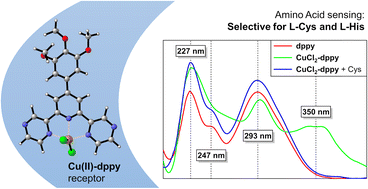A simple copper(ii) dppy-based receptor for sensing of l-cysteine and l-histidine in aqueous acetonitrile medium†
Abstract
The development of simple yet efficient receptors that rapidly detect and monitor amino acids with high sensitivity and reliability is crucial for the early-stage identification of various diseases. In this work, we report the synthesis and characterisation of a copper(II) complex, CuCl2L, by employing a 2,6-dipyrazinylpyridine (dppy)-based ligand (L = 2,2′-(4-(3,4,5-trimethoxyphenyl)pyridine-2,6-diyl)dipyrazine). The in situ prepared CuCl2L receptor exhibits an instantaneous response to the presence of L-cysteine (Cys) and L-histidine (His) in aqueous acetonitrile (4 : 1 v/v, 10 mM HEPES buffer, pH 7.4). Furthermore, competitive experiments demonstrate the selectivity of CuCl2L towards Cys (1 equiv.) in the vicinity of other L-amino acids in the aforementioned solvent conditions. The detection limits for Cys and His are calculated as 0.33 μM and 1.40 μM, respectively. DFT calculations offer a plausible explanation for the observed selectivity of the CuCl2L receptor towards Cys and His. They reveal that the most stable conformer of Cu : Cys complex (1 : 1) is a five-membered ring formed through N,S-coordination mode (ΔG = −26.7 kcal mol−1) over various other possible coordination modes, while comparable ΔG values are only obtained for Cu : His complexes featuring two His moieties.



 Please wait while we load your content...
Please wait while we load your content...